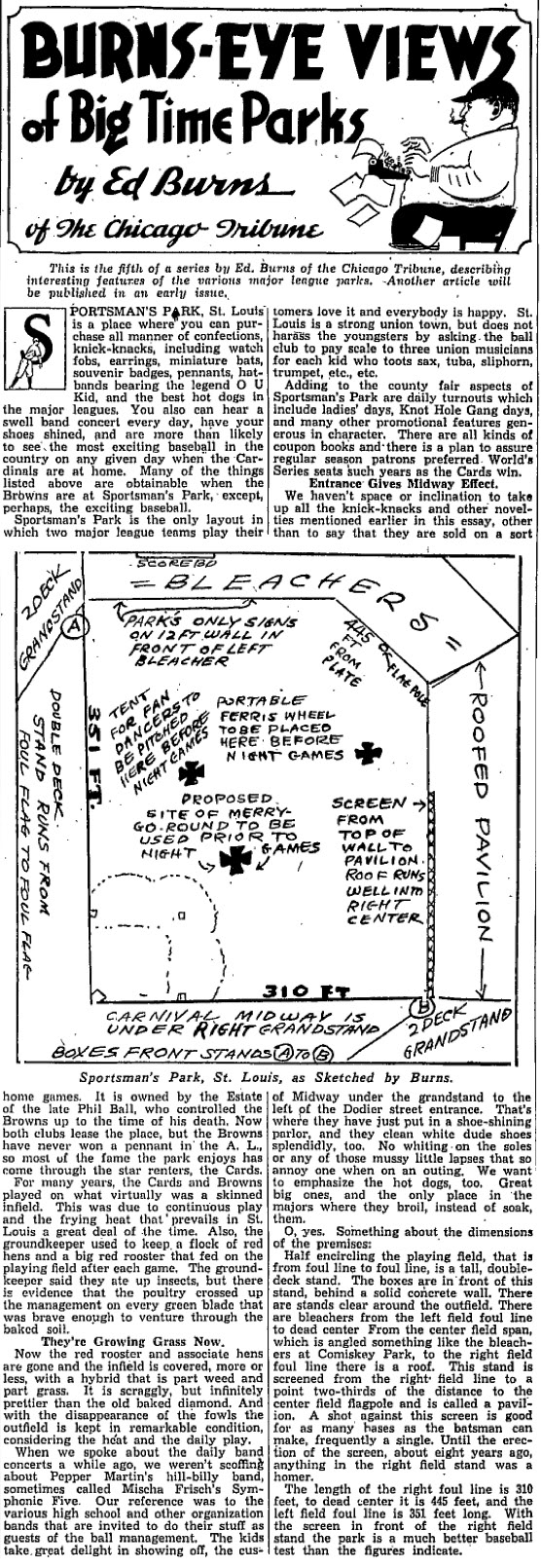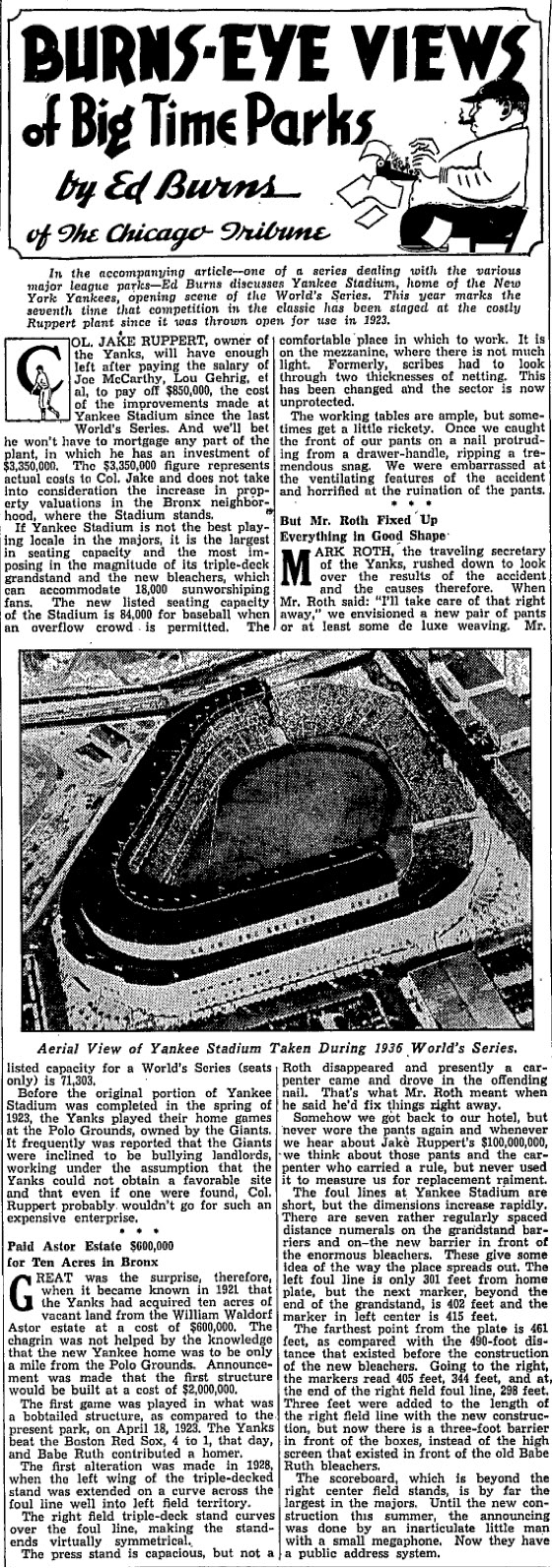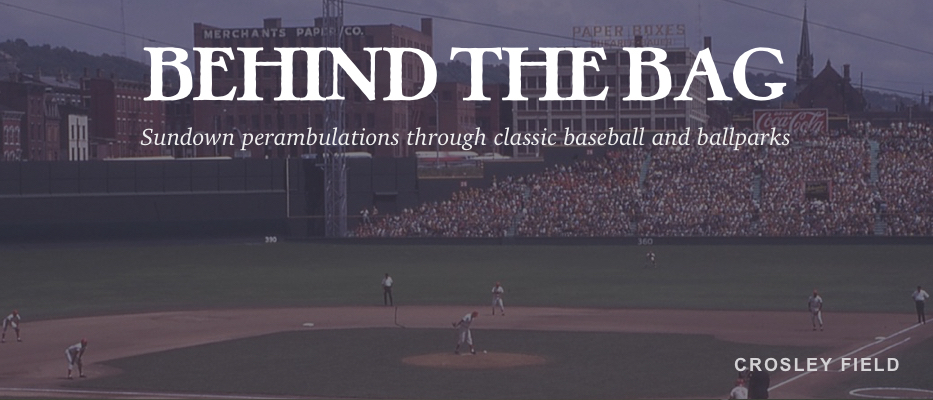In 1937, Ed Burns, a sportswriter for the Chicago Tribune, penned a series of articles on every major league park at the time (15 articles in all, of 16 parks for 16 teams; the Cardinals and Browns shared Sportsman’s Park in St. Louis, while the Indians played in both League Park and Cleveland Municipal Stadium that year, with one article for both), which were also published in the Sporting News that year.
Years ago, I had been perusing through the SN archives (while researching something else entirely), when I stumbled upon this series, largely if not completely forgotten, and felt that it deserved to be seen again, so I painstakingly screen grabbed and saved every article; I had then posted them individually in their respective threads over at the Baseball-Fever.com ballparks area (as my alpineinc alter ego), and also sporadically on this blog, but in seeing them pop up continually on the web, I decided to finally put them all together in one large post, for all to see and enjoy at once.
A very interesting series, especially from the perspective of 1937, and the hand-drawn diagrams of interesting plays and quirks of virtually every park are wonderful. They are listed below in the order of when they were published (with their respective tenants), as follows (again, 16 parks, 15 articles):
- Braves Field (Boston Braves)
- Baker Bowl (Philadelphia Phillies)
- Polo Grounds (NY Giants)
- Ebbets Field (Brooklyn Dodgers)
- Sportsman’s Park (St Louis Cardinals and St Louis Browns)
- Shibe Park (Philadelphia Athletics)
- Yankee Stadium (NY Yankees)
- Fenway Park (Boston Red Sox)
- Navin Field (Detroit Tigers)
- Comiskey Park (Chicago White Sox)
- Cleveland Stadium and League Park (Cleveland Indians)(Split time between both parks, and one article was written to include both parks)
- Forbes Field (Pittsburgh Pirates)
- Crowley Field (Cincinnati Reds)
- Griffith Stadium (Washington Senators)
- Wrigley Field (Chicago Cubs)
First up, Braves Field in Boston, or what was known as “National League Park” (not Field as noted below) at that time since the Braves were the “Bees” from 1936-1940, and to differentiate from the American League field in Boston, or Fenway Park.

Second in the series, the old Baker Bowl in Philly, one of two parks in Philadelphia in those days, home of the Phillies (the A’s played in nearby Shibe Park, soon to be Connie Mack Stadium), and confusingly, was also officially known as National League Park, similar to Braves Field, above. A less than flattering review below, which must have rang true, as the Phillies abandoned the Baker Bowl midway through the following season (1938), to join their city stablemates down the road in larger, newer Shibe.

Batting third, the Polo Grounds, home of the New York Giants from 1911-1957, the Yankees from 1913-1922, and the Mets in 1962 and 1963. It is one of the most classic of all ballparks, but Mr. Burns isn’t pleased with the dimensions at all. Also, apparently Mel Ott’s HOF career has a lot to do with the amount of (politically incorrect) home runs he hit there. Also, “there has never been a game of polo at the Polo Grounds”.

In the cleanup spot is classic Ebbets Field, the Brooklyn Dodgers’ home from 1913-1957, and one of the most beloved of all the classic parks. Also it had a prominent feature that was copied by Citi Field, and similar to some Mets fans’ reactions today, “Entrance Through Huge Rotunda Confuses Customer”.

Fifth in the series, Sportsman’s Park, home to both the St. Louis Cardinals and Browns. How about roosters and hens to eat all the insects that would plague the field, and the only place in MLB you can get a hot dog that is broiled instead of “soaked”!

Sixth in the series is Shibe Park, home to the Philadelphia Athletics. The Phillies were still up the street in smaller Baker Bowl, but since the late Mr. Shibe added accommodations for their Brotherly Love brethren (including the then vacant “Phillyless Philly Clubhouse”, see and read below), they gave up on the old park and moved into beautiful Shibe for good in 1938. Although it looks like a “warehouse or brewery” from the outside, it’s hard to beat the best grass in the majors!

Seventh in the series, none other than the House That Ruth Built, Yankee Stadium itself. And as it remains today, much of the talk of the Yankees and their stadium is directly related to obscene amounts of money. Little else to complain about, especially with the “new construction this summer”; “the announcing was done by an inarticulate little man with a small megaphone…now they have a public address system”, unfortunately Bob Sheppard still being decades away. And for the mighty Yanks the Tribune saw fit to include the first actual ballpark photograph of the series.

Eighth in the series, venerable Fenway Park, which, while classic today, back then had “no apparent reason for the outline of the field having similarity with…a tough jig saw puzzle.” Sounds like the complaints of the contrived designs of “retro” ballparks today, almost 80 years later.

Batting ninth, Navin Field, which would become Briggs Stadium (the new owner who just remodeled it as noted below, and who would eventually name it after himself in 1938) and eventually, good old Tiger Stadium. The expansion in 1936 resulted in the “only two-deck bleacher in the majors”, which would soon enough not be called bleachers at all, but simply a 2-tier deck in the outfield. And more importantly, a correction from Mr. Burns: Sportsman’s Park in St. Louis was not the only park of the day to have “luscious broiled hot dogs” instead of “soaked” ones – this newfangled broiled treat was also cheerfully served at Navin Field. And finally, in a bit of sad irony, Navin Field was considered the “best located park in the majors, from the viewpoint of proximity to the central business district”; unfortunately, that location would be considered less desirable decades later.

Into extras, and tenth in the series, Comiskey Park, or “greater Comiskey”, as Burns puts it. The South Side stadium contains “14 acres, the largest playing field devoted to baseball in the United States”, but through a loophole, as the larger Cleveland Stadium tract was also used for other purposes. And the windows (actually a telltale trademark of old Comiskey) “make (the) concrete stands breezy”. Lastly, don’t let anyone tell you this used to be a dump – just a truck garden. And although they reaped one WS crown in 1917 (and should’ve had another in 1919), they wouldn’t have another in the old park – but they did harvest an AL pennant in 1959.

Eleventh in the series, and a bonus 2 for 1 here. The Indians were in the midst of a slow transition to cavernous Cleveland Municipal Stadium, where they had been playing some games since 1932, but the large size of the park coupled with the lingering Great Depression and lower attendance, kept the Tribe playing in smaller League Park as well. The cozier park had its charms, but according to Burns boasted “the silliest dimensions in the American League” and a “joke right field wall”, also noted in the drawn diagram as well. In fact, Burns even argued that League Park put the Indians at a disadvantage, as the locals tried to perfect the “ladle” of a batted ball over the short right field wall, which also resulted in easy pop flies on the road and made the team “all mixed up”. So, it only made sense that the Indians would eventually move full-time to the “best ball park in America”, and its symmetrical layout is also highly praised here; but, while Cleveland Municipal was a fine stadium in its own right, I’d guess that Burns and his cohorts spent little time in the park during blustery April contests.
Number twelve, Forbes Field, with “by far the most beautiful setting in the major leagues”, primarily due to the view of Carnegie Tech and the Mellon mansions. Also, Forbes’ famous expanse of foul territory behind the plate is already well evident.

Lucky thirteen is Crosley Field, formerly Redland Field, the “most colorful park in the majors”, due to the varying colors used to paint the park, and maybe also the wettest, as a recent flooding from the nearby Ohio River is discussed. And the press box is aces.

Fourteenth is Griffith Stadium, in our nation’s capital. As it turns out, US Vice President Garner is a much more frequent visitor to the ballpark than FDR. And it appears that the left field bleachers, the biggest in baseball, is often the “hottest place on the North American continent”.

The fifteenth and final entry in the series is none other than Chicago’s Wrigley Field, voted “most artistic” by Mr. Burns. And then, as now, the fans were contending with a major renovation in progress. And get this, they’re actually going to have ivy growing on the walls for 1938!

And that’s it, a nice overview of every major league park in the year 1937, pre-war, pre-franchise relocation, pre-expansion, pre-everything. One wonders what Mr. Burns’ take would be on every current ballpark, but besides disbelief over food offerings fit for kings and exorbitant prices league wide, I’d guess there would still be an age-old emphasis on creature comforts, and an overriding reluctance to any changes of the grand old game. Much like today.


Tom – SO GLAD YOU AE BACK!!!
Jim Montemurro Westfield, NJ If you ever have a bus trip to CitiField for a Mets game, please let me know. Thanks.